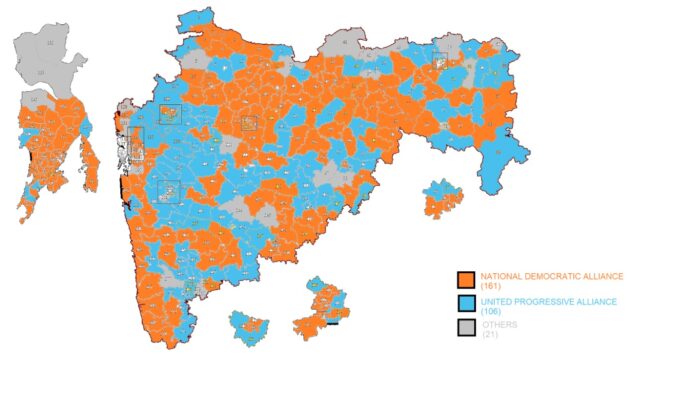“There is undercurrent discontent against the BJP and sympathy for the INDIA alliance in both states!”

By Umakant Lakhera*
NEW DELHI: The assembly elections in Maharashtra with 248 seats and the tribal-majority state of Jharkhand with 81 seats are taking place at a time when the surprising results from Haryana, adjacent to Delhi, have made the upcoming elections in these two states intriguing. In Maharashtra, contradictions are evident: On one hand, the BJP-backed Eknath Shinde government is facing accusations of corruption, misuse of power, and depleting the state treasury under the guise of populist schemes. Ironically, in Jharkhand, the BJP is relying on similar allegations to come to power, the very ones it is grappling with in Maharashtra.
In Haryana, the BJP outmaneuvered a fragmented Congress in a tight contest, partly because Congress lost nearly 22,000 votes and trailed behind the BJP by a slim margin in 9 seats, including from the Indian National Lok Dal (INLD). However, the electoral dynamics in Maharashtra and Jharkhand are completely different. In both states, Congress plays a junior or coalition partner role. The BJP lacks a charismatic leader to compete with Uddhav Thackeray, Sharad Pawar in Maharashtra, and Hemant Soren in Jharkhand. Hence, it is forced to rely solely on Narendra Modi’s image and Amit Shah’s political maneuvering.
Notably, in the last Lok Sabha elections, the Maha Vikas Aghadi (MVA) secured 30 out of 48 seats in Maharashtra, a significant setback for the Modi government at the center. This was partly attributed to the BJP’s failure to anticipate the growing sympathy in the state for the opposition alliance, following the toppling of Uddhav Thackeray’s government and the division of his party. All eyes are now on whether the results of Haryana will be repeated in Maharashtra and Jharkhand in a month and a half.
The political and ground realities in Maharashtra and Jharkhand are vastly different from Haryana. In Maharashtra, the ruling Mahayuti alliance faces direct competition from the opposition Maha Vikas Aghadi (MVA). Both alliances consist of three factions. Eknath Shinde, leader of the Shinde faction of Shiv Sena, split the party founded by Balasaheb Thackeray in 2022 and joined forces with the BJP to topple the Maharashtra government, eventually allying with Ajit Pawar and the BJP.
Similarly, Ajit Pawar, with backing from the BJP central leadership, broke ties with his uncle, Sharad Pawar, the founder of the Nationalist Congress Party (NCP), and joined the Eknath Shinde government as Deputy Chief Minister. Meanwhile, Devendra Fadnavis, the former Chief Minister, had to accept the role of Deputy CM in the government formed through this political coup. Despite completing their tenure, the Mahayuti government is facing several challenges in contesting the assembly elections together.
Among the Mahayuti alliance, Ajit Pawar is considered the weakest link. Until recently, he was trying to reconcile with his uncle, Sharad Pawar, to return to his fold. When he switched sides, he was under investigation by the Enforcement Directorate for a ₹70,000 crore irrigation scam, but his troubles vanished after joining the BJP. However, Ajit Pawar’s influence remains limited to areas where Sharad Pawar has a strong base. In the last Lok Sabha elections, Ajit Pawar barely managed to secure one seat, and his wife, Sunetra Pawar, lost badly to Sharad Pawar’s daughter, Supriya Sule, in Baramati.
Eknath Shinde’s Shiv Sena won 7 seats in the Lok Sabha, while the BJP had to settle for just 9. Shinde’s faction is now pushing for a proportionate allocation of assembly seats based on the Lok Sabha results. However, with the election dates announced, the BJP has fielded candidates for 99 seats, sidelining both Shinde’s faction and Ajit Pawar. The BJP reportedly made it clear to Shinde in Delhi that it expects to get more seats since it sacrificed a lot by making him Chief Minister, especially after making Devendra Fadnavis his deputy. The BJP argues that most of the votes won by Shinde’s faction in the Lok Sabha elections came from North Indian migrants, who traditionally form a strong BJP base in Mumbai and other regions.
The BJP is gradually sidelining Eknath Shinde’s Shiv Sena, as it believes that despite the backing of the central government and the BJP’s leadership, Shinde has failed to significantly weaken Uddhav Thackeray. On the other hand, the Congress, which won only one seat in 2019, surged ahead this time, securing 13 seats.
Tensions have already surfaced between BJP leader Devendra Fadnavis and Chief Minister Eknath Shinde over the distribution of tickets and the next chief ministerial candidate. The BJP and the RSS are striving to ensure that if the BJP emerges as the largest party in the elections, it can put forward its candidate for Chief Minister. However, it seems unlikely that the BJP will be able to form a government on its own. Post-election, the futures of both Shinde and Ajit Pawar will depend on the results.
In Maharashtra, the BJP and Shinde’s faction delayed the elections by two months to implement the Ladli Behna Scheme, but the Mahayuti alliance has failed to turn the tide completely in their favour. After Haryana’s success, the BJP has managed to gain some leverage over Shinde and Ajit Pawar in seat negotiations, but challenges remain.
The Maratha reservation issue has become a significant obstacle for the BJP in Maharashtra. Manoj Jarange Patil has emerged as the leader of this movement and has fielded his candidates in many places, which could cut into the votes of both alliances. Patil’s supporters believe he is working to defeat the BJP, as attempts were made to weaken his movement during Fadnavis’s tenure as Chief Minister.
Jharkhand
In Jharkhand, BJP’s central leadership has been trying to destabilize the coalition government of Jharkhand Mukti Morcha (JMM) and Congress. Chief Minister Hemant Soren has turned these efforts into a major election issue, accusing the BJP of trying to wrongfully imprison him and frame him in false cases. The JMM is highlighting these issues as part of its electoral strategy. To cut into traditional JMM votes, especially in tribal areas, the BJP has devised a multi-pronged strategy.
In response, Congress has strengthened its grip on urban middle-class, Dalit, OBC, and minority votes, while the JMM has built new support among tribals, Muslims, and Christian voters in its strongholds. The INDIA alliance has created challenges for the BJP even in urban constituencies where the BJP was once considered strong. Inflation and unemployment remain key issues, with the Soren-Congress alliance appearing to have an edge over the BJP.
The BJP has employed a strategy of fielding defectors like Champai Soren, who was briefly made Chief Minister, to break into JMM’s tribal base. The BJP has created multi-cornered contests in many constituencies by fielding candidates from smaller parties and independents.
The contest in Jharkhand is shaping up to be intense. The BJP, leading the NDA alliance, is contesting in 68 seats. Most of its tickets have been given to defectors from other parties. The BJP’s ally, AJSU, may contest 10 seats, while the JDU has been allocated two seats, and Chirag Paswan’s LJP has one seat. However, disputes over seat allocation among alliance partners may lead to the emergence of independent candidates.
*The author is a Delhi-based veteran journalist.





